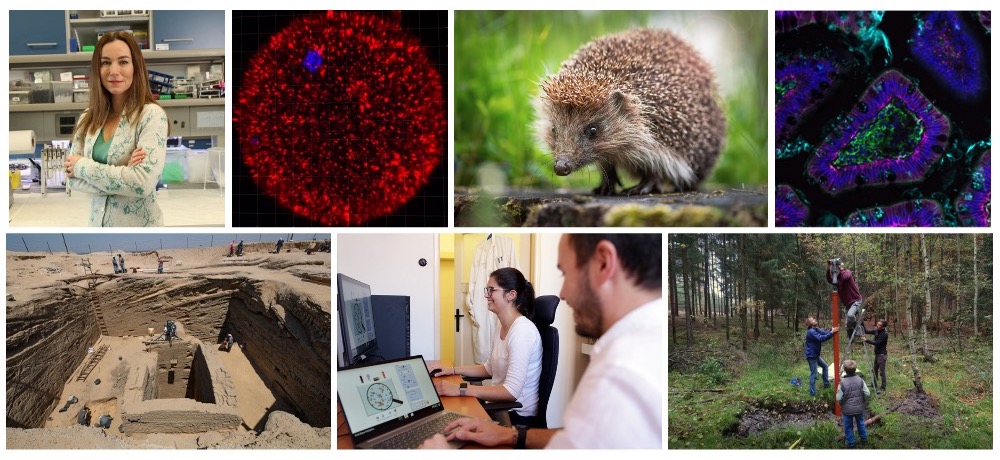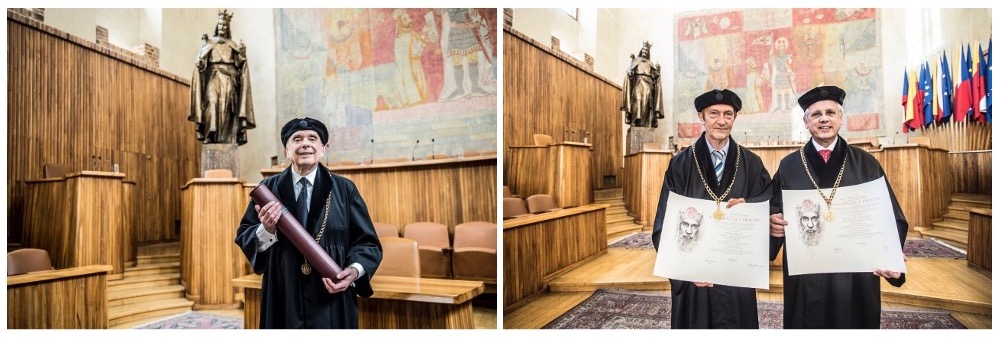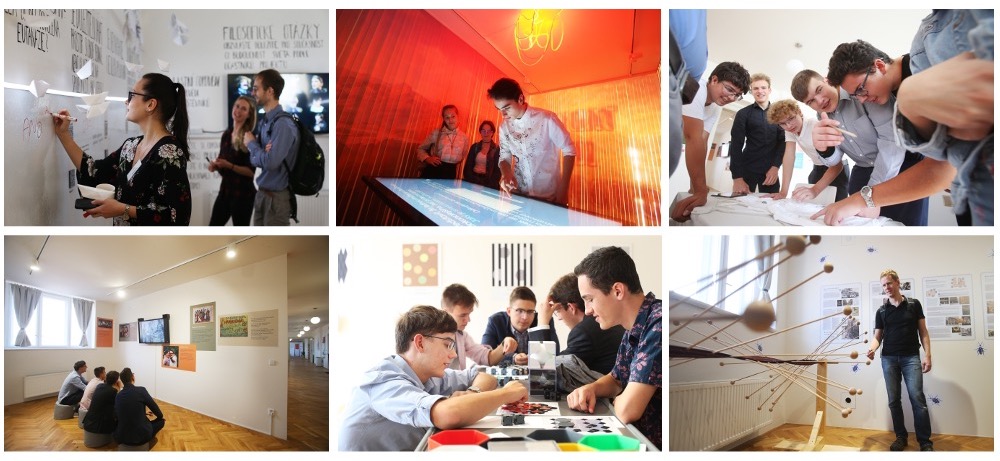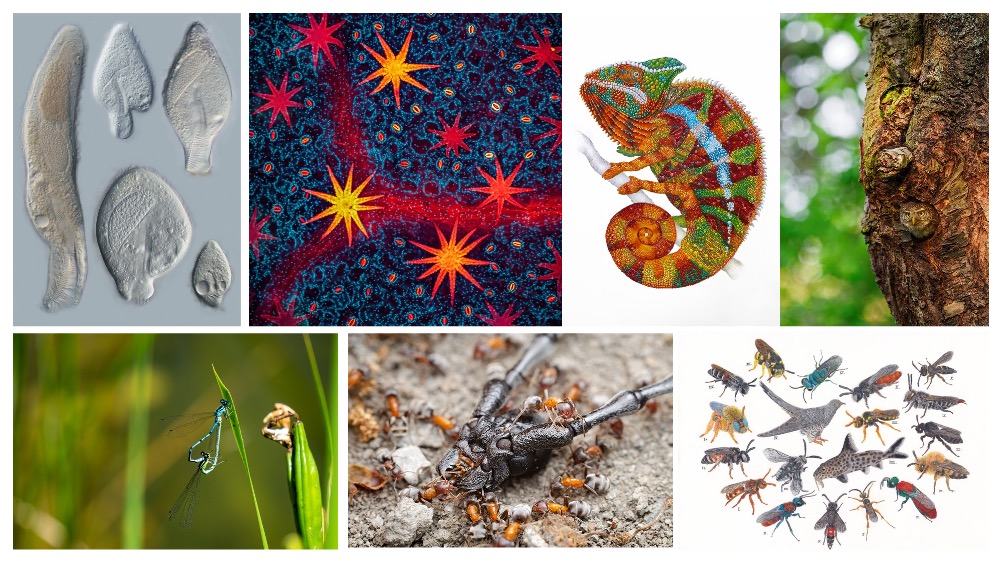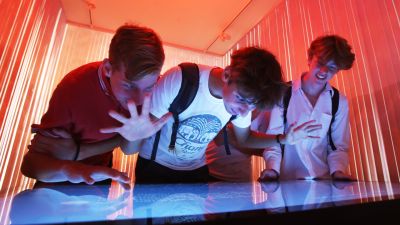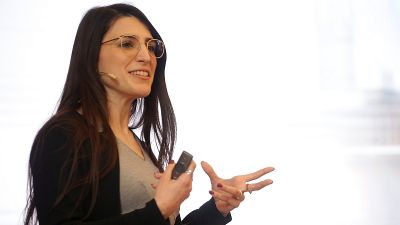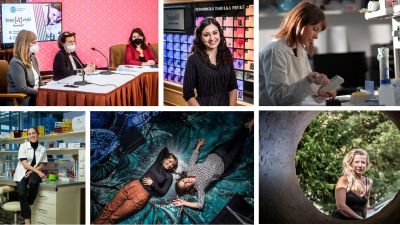Dictionary.com chose “woman” as its word of the year for 2022, an apt choice which could apply to Charles University. In February, for the first time in its history, the position of rector was taken up by a woman: professor and scientist Milena Králíčková. The events of 2022 - the receding Covid pandemic, the Czech EU Presidency, the economic crisis and the Russian invasion of Ukraine - demonstrated the importance and necessity of science, which provides information, explanations and solutions. Therefore, we offer our readers a look back at scientific achievements and important moments of the past year.
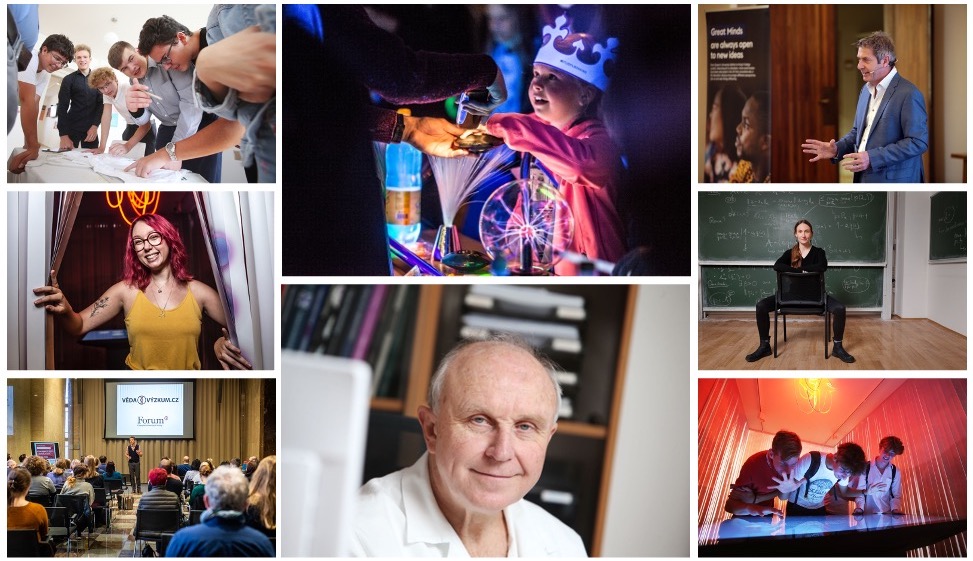
The year in science: Jan Starý (bottom centre) was among key figures awarded, others received grants, and there were key popularisation events.
Four prestigious ERC grants for the Faculty of Physics and Mathematics
The Faculty of Physics and Mathematics (affectionately known as Matfyz) scored high in this year's competition for prestigious European Research Council (ERC) grants: three ERC Starting grants and one ERC Synergy grant. Ondřej Dušek wants to create a universal natural language generator that learns from just a few examples and does not make mistakes. Martin Kozák was awarded a grant to research new electron microscopy capabilities that will allow to sense the motion of electrons in substances with high spatial and temporal resolution. Erin Carson wants to change the way people approach creating and analyzing computational algorithms for the world's largest supercomputers. And Libor Barto is researching mathematical problems within the ERC Synergy project together with colleagues in Vienna and Dresden are trying to better understand complexity in computation. “We want to know which problems can be solved quickly on a computer and which ones cannot,” says Barto, whose ideas got a boost from an earlier ERC Consolidator grant he is currently completing.
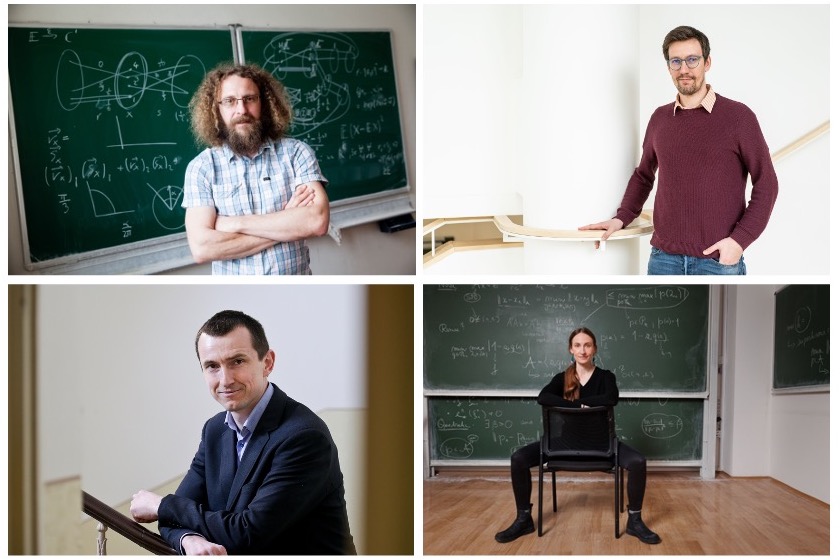
New ERC grant recipients at CU: Libor Barto (top left), Ondřej Dušek, Martin Kozák (bottom left) and Erin Carson.
Prestigious publications and commenting on current events
Should I get vaccinated? Almost everyone was looking for an answer to this question during the Covid pandemic. A team of four Czech economists, brought together by Charles University a few years ago, examined how and people made their decisions. And revealed how wrong the sceptical public was. “The public thought that only about half of doctors trusted vaccines against Covid-19. We demonstrated that simply communicating this consensus provided a simple and durable way to reduce vaccine resistance,” summarise Michal Bauer and Julie Chytilová of CERGE-EI in a separate interview for Forum. The misconceptions about experts' confidence in vaccination, but also about their views on climate change, for example, are most likely inflated by the media, which, in their attempt to be objective, give equal space to extreme views without emphasising how proportionate they are. The research, which was published in one of the most prestigious scientific journals, Nature (as the first ever social science study with Czech authors), is now summarised in a lighter form in a video.
Another international study in the elite Nature, co-authored by Pavel Hulva from the Faculty of Science of the Charles University, revealed that hedgehogs are natural carriers of resistant golden staphylococcus aureus bacteria, the dreaded MRSA (methicillin-resistant Staphylococcus aureus), against which common antibiotics do not work and which is a common “hospital infection” that seriously complicates even trivial procedures. Surprisingly, the study found that hedgehogs had already “grown” MRSA around 1800, long before the discovery of antibiotics. This is because hedgehogs host fungi on their skin that produce beta-lactam antibiotics (a group that includes penicillin), so only “antibiotic-resistant” - resistant bacteria - have a chance of surviving on them.
The team of Kateřina Komrsková from the Faculty of Science of Charles University and the BIOCEV Centre discovered a fusion protein in the female egg that plays a key role in the moment when the sperm penetrates the egg. Knowledge of the MAIA protein may thus help in improving the diagnosis and treatment of infertility, or in the development of new types of contraception.
An archaeological team from the Czech Institute of Egyptology, Faculty of Arts, Charles University, has discovered the tomb of the ancient Egyptian dignitary and “commander of foreign mercenaries” Vahibre-meri-Neita. Although it was looted in ancient times, it provided valuable information. Due to the untimely death of the owner, it was left unfinished and the very austere funerary equipment thus reveals what the Egyptians considered absolutely essential in decoration and funerary equipment. The tomb is also unique in its layout, which has caused researchers to frequently change the excavation.
Has the field remained a field or has it become overgrown? Paleoecologists from Charles University and the Academy of Sciences asked this question in an international study, using innovative analysis of pollen grains in sediments to monitor the effects of the 14th century plague pandemic, the Black Plague. “We looked at how the agricultural landscape changed after the plague and inferred demographic changes from that. In other words, in places where many people died, fields started to become overgrown because there was no one to cultivate them,” paleoecologist Petr Pokorný told Forum.
|
For a better overview and a data-driven approach, we recommend applications developed by Daniel Münich and colleagues in the IDEA project at CERGE-EI. One of the latest applications, for example, maps the publishing performance of Czech research institutes with a distinction of the scientific impact of research, also with respect to the staff size of the institutes at the disciplinary level, which has not been possible to take into account so far, as pointed out by Associate Professor Münich in a separate article at the Forum website. Another application, for example, compares the citation response of publications from Czech research institutes in context, while another maps the still frequent inbreeding in the Czech Republic. |
Experts from CU also regularly explained and commented on current events in the media. Among the most visible were commentators on the development of the Russian invasion of Ukraine, such as Michal Smetana or Jan Ludvík as well as Emil Aslan. In this context, scientists from Matfyz also used their knowledge, who very quickly developed a Czech-Ukrainian dictionary based on machine translation, which also works as an Android mobile application, where it can recognize and translate the spoken word. Charles University and its experts were also actively involved in the Czech EU Presidency, the death of Queen Elizabeth II and the devastating fires in Hřensko.
|
Science 2022 at Charles University - The Vice-Rector for Science Ladislav Krištoufek, with whom we talked about “science at CU” in the latest Forum print magazine, is one of the 10 most cited scientists working in the Czech Republic, according to the Highly Cited Researchers 2022 index. - Rector Milena Králíčková met with young female scientists as part of the traditional networking brunch organized by the NKC Gender and Science. “It is important to have people around you who support you and help you grow. And I am lucky enough to have always had them in my life,” CU’s first female rector said. - As a research institution, how do you protect yourself from threats from abroad? Experiences and approaches from Imperial College London were openly shared by British expert Lynne Cox in a seminar held at Charles University in September. “Many countries spend a lot of money on teaching and research in universities, but sometimes they neglect a little bit the possible security threats. But these are real, so universities should work closely with the government on these issues,” she summarised for the Forum. - The first edition of the UKa! competition, which aims to enable CU students to creatively promote their alma mater, was won by the student team behind the podcast Pod Cap. In each episode, they bring to the general public interesting facts from the world of science and the life of scientists as it really is. As part of their winning project, they specifically target high school students, introducing them to the faculties through live debates. |
So many awards...
The legendary band ABBA may sing “money”, but at Charles University, perhaps the song could be reinterpreted as “awards”. Scientists with affiliation to Charles University collect national and international scientific prizes. For 2022, we can name, for example, the Czech Head Award, which is called the “Czech Nobel Prize”, for ecologist and botanist Petr Pysek (who also works at the Botanical Institute of the CAS), the Milada Paulová Prize for neuroscientist Eva Kubala Havrdová from the First Faculty of Medicine of Charles University, or the Neuron Prize, which Charles University dominated this year - six awards out of nine categories belong to laureates from Charles University! The main Neuron Prize for lifetime contribution to science in the field of medicine was awarded to haematologist and oncologist Jan Starý from the Second Faculty of Medicine of Charles University.
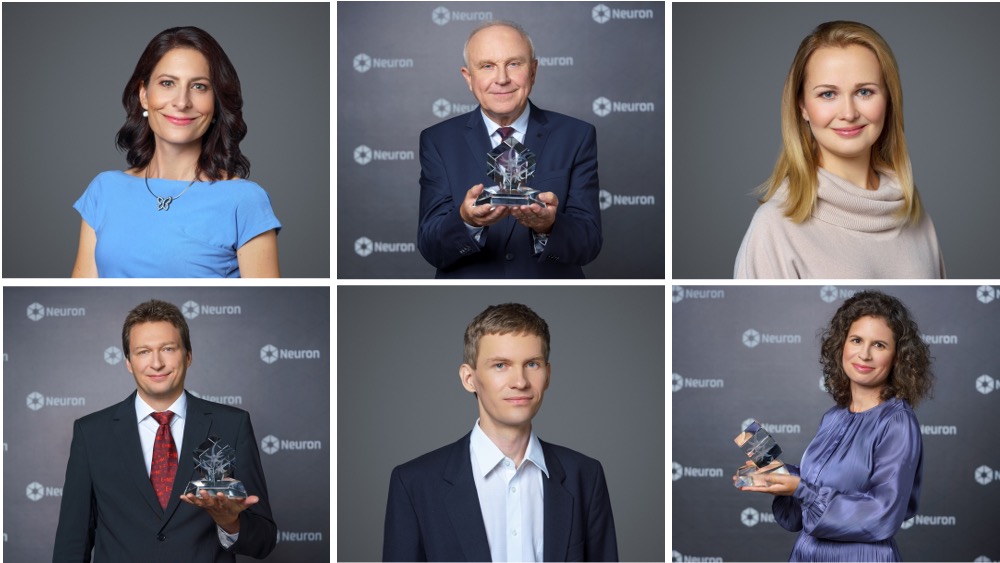
Neuron laureates from CU. Above: Martina Živná, Jan Starý, Marya Shamzhy. Below: Martin Setvín, Jan Kynčl and Anežka Kuzmičová.
On the occasion of the celebration of the 674th birthday of Charles University, five male and female scientists were awarded the prestigious research grant Donatio Universitatis Carolinae. The award was given for the sixth time this year and carries a prize of one million crowns. The newly selected company of awardees includes: demographer Dagmar Dzúrová, mathematical linguist Jan Hajič, organic chemist Martin Kotora, turkologist Jitka Malečková and haematooncologist Jan Trka.
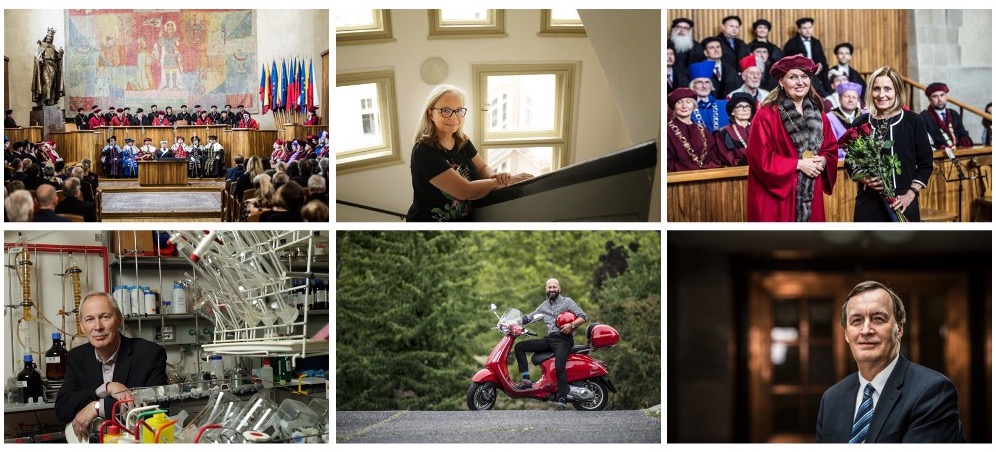
Donatio recipients: Dagmar Dzúrová (top row, middle) and Jitka Malečková. Bottom row from left: Martin Kotora, Jan Trka and Jan Hajič.
In 2022, three honorary degrees of Doctor honoris causa of Charles University were also awarded. In April, Canadian physician Professor David Norman Weisstub was awarded the title of Dr.h.c. for his “significant contribution in the field of ethics and bioethics with global impact”. In October, Professor Jiří Bártek, a graduate of the First Faculty of Medicine of Charles University, now working at Karolinska Institutet and the Danish Cancer Society Research Center, for “pioneering discoveries in the fields of cell biology and cancer research, which are a significant contribution to biomedicine, and for helping Czech science”, and Professor Jacques J. M. van Dongen from Universiteit Leiden for “outstanding contribution to research, classification and diagnostic stratification of malignant and non-malignant hematopoietic disorders”.
|
Charles University is involved in all EXCELES projects The EXCELES programme - announced at the end of 2021 by the Ministry of Education, Youth and Sports (MoEYS) - was created to support research, experimental development and innovation in the health sector as part of the National Recovery Plan. Scientific institutions across the Czech Republic joined forces to create five "virtual" research centres, which are generously funded by the European Union. Joining forces should improve the efficiency of research and respond more quickly to current and future challenges. Specifically, these are: National Cancer Research Institute (NCRI) National Institute for Metabolic and Cardiovascular Disease Research (CarDia) National Institute of Virology and Bacteriology (NIVB) National Institute for Neurological Research (NINR) National Institute for Research on the Socioeconomic Impact of Disease and Systemic Risk (SYRI) |
Science at Play. Not only in the Didactikon
What is love? How does sound spread? How does sight deceive us? How much science is in the popular Simpsons series or what can artificial intelligence already do? Visitors to the Didaktikon Education Centre, which is located at Kampus Hybernská, are exploring these questions. It is a joint project of the Prague City Hall and Charles University and is aimed mainly at primary and secondary school pupils and students and their teachers. However, it also offers events for the general public or courses of the University of the Third Age or educational courses for teachers
Experienced with all the senses
Visitors to the traditional Researchers' Night, which this year was subtitled All the Senses and attracted a record number of participants, could see, taste, hear or touch science. Among other things, the Night of Scientists also brought the winner of the national final of the FameLab standup competition - Eliška Jandová from the Faculty of Science of Charles University. She also scored points with her performance about finding hope in a drop of blood in the international online final in Cheltenham, where she finished in a shared second place.
Eliška Jandová in the iinternational FameLab final at 55:15 min.
Science communication was the central theme of two conferences and a number of workshops. In February, UK experts gathered in Prague or joined online to share their experiences and tips at the ScienceCommunication: UK Experience conference. The conference can be watched for free from a recording. This was followed in November by the Science Communication and Social Networks conference.
CU graduates will not be lost in the world
One of our regular features is the Czexpats from CU series, which brings stories of successful Charles University graduates who work scientifically abroad, but mostly stay in touch with the Czech Republic and some even return enriched by new experiences.
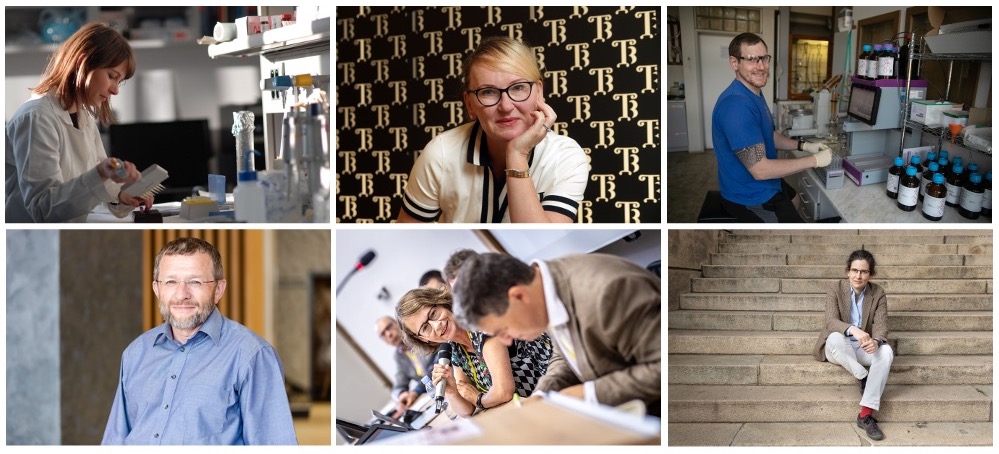
Czexpats from CU series incl. (from left) Kateřina Rohlenová, Ivana Schnur, Jan Nekvinda, Vladimír Beneš, Petra Gümplová and Irena Kalhousová.
What else to add? Science is beautiful, as is the name of the traditional competition of the Faculty of Science for the most beautiful photographs and illustrations with a scientific theme. This year's winner was Jan Martinek's microphotography Starry Sky under the microscope, the laws of optics in me. In the scientific illustration category, for example, Polina Belyaev's drawing Chameleon Pardal.


